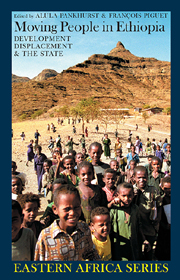Book contents
- Frontmatter
- Contents
- Acknowledgements
- Acronyms
- Glossary
- Notes on Contributors
- Preface: An Original Contribution to Country-wide Displacement Analysis
- Foreword by Alula Pankhurst & François Piguet
- Map
- Part I INTRODUCTION
- Part II THEORETICAL & INTERNATIONAL PERSPECTIVES
- Part III DEVELOPMENT-INDUCED DISPLACEMENT
- 4 Social Dimensions of Development-Induced Resettlement
- 5 The Effects of Development Projects on the Karrayu & Afar in the mid-Awash Valley
- 6 The Effects of Investment on the Livelihoods of the Tsamako in the Wayto Valley
- 7 Planning Resettlement in Ethiopia
- 8 Urban Development & Displacement of Rural Communities around Addis Ababa
- Part IV THE EXPERIENCE OF STATE-ORGANIZED RESETTLEMENT
- Part V THE DILEMMAS OF REFUGEES, RETURNEES & DISPLACED GROUPS
- Part VI CONCLUSION
- Bibliography
- Index
- EASTERN AFRICAN STUDIES
8 - Urban Development & Displacement of Rural Communities around Addis Ababa
from Part III - DEVELOPMENT-INDUCED DISPLACEMENT
Published online by Cambridge University Press: 05 April 2013
- Frontmatter
- Contents
- Acknowledgements
- Acronyms
- Glossary
- Notes on Contributors
- Preface: An Original Contribution to Country-wide Displacement Analysis
- Foreword by Alula Pankhurst & François Piguet
- Map
- Part I INTRODUCTION
- Part II THEORETICAL & INTERNATIONAL PERSPECTIVES
- Part III DEVELOPMENT-INDUCED DISPLACEMENT
- 4 Social Dimensions of Development-Induced Resettlement
- 5 The Effects of Development Projects on the Karrayu & Afar in the mid-Awash Valley
- 6 The Effects of Investment on the Livelihoods of the Tsamako in the Wayto Valley
- 7 Planning Resettlement in Ethiopia
- 8 Urban Development & Displacement of Rural Communities around Addis Ababa
- Part IV THE EXPERIENCE OF STATE-ORGANIZED RESETTLEMENT
- Part V THE DILEMMAS OF REFUGEES, RETURNEES & DISPLACED GROUPS
- Part VI CONCLUSION
- Bibliography
- Index
- EASTERN AFRICAN STUDIES
Summary
Introduction
Internally Displaced People (IDPs) are among the least studied categories of people in the world and, hence, there are no internationally agreed operational definitions for them (Hampton 1988). The working definition that was used by the Brookings Institution and the Global IDP survey describes them as ‘persons or groups of persons who have been forced to flee or to leave their homes or places of habitual residence as a result of, or in order to avoid, in particular, the effects of armed conflict, situations of generalized violence, violations of human rights or natural or human-made disasters, and who have not crossed an internationally recognized state border’. Some scholars (McDowell 1996; Sorensen 1998) argue that this definition does not give the necessary emphasis to people displaced by development projects. We can, therefore, adapt the operational definition for ‘development-induced displaced people’ as ‘persons or groups of persons who are forced to leave their lands or homes or their possessions as a result of a development process that undermines, excludes or ignores their full participation in development and puts their livelihoods in danger without protection, in a given national territory’.
The number of IDPs is increasing with about 10 million people worldwide entering the cycle of forced displacement and relocation on an annual basis, mostly due to development projects for urban and transport infrastructure and dam construction. Of these, urban development projects reportedly cause the displacement of some 6 million people every year (Cernea 1995).
- Type
- Chapter
- Information
- Moving People in EthiopiaDevelopment, Displacement and the State, pp. 102 - 118Publisher: Boydell & BrewerPrint publication year: 2009



